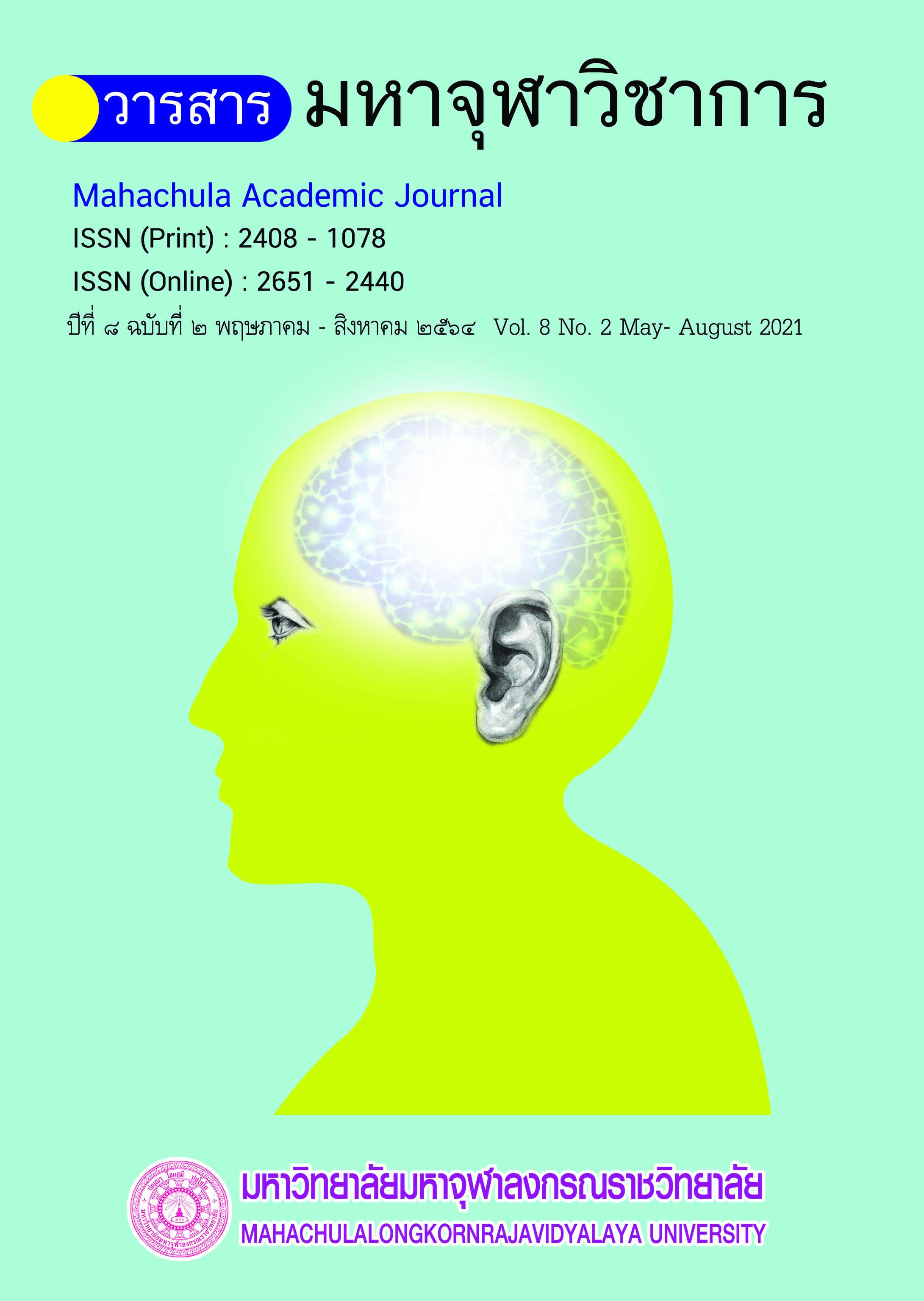Faith Empowerment to Wisdom : A Case Study of Luang Por Sothon, Chachoengsao Province
Main Article Content
Abstract
The faith empowerment to wisdom: a case study of Luang Por Sothon, Chachoengsao Province, the 3 objectives were (1) to study concepts and teachings about faith and wisdom in Buddhism; (2) to analytically study the people’s faith towards Luang Por Sothon, Chachoengsao Province; and (3) to propose a way to empower faith to the wisdom of the people who come to worship Luang Por Sothon. This is qualitative research; the documented data collection and in-depth interviews were carried out with 11 key informants.
The findings were as follows: There are 4 concepts of faith in Buddhism: (1) Kamma-saddhā, (2) Vipāka-saddhā, (3) Kammassakatā-saddhā, and (4) Tathāgata Bodhi-saddhā. There are two characteristics of faith: faith with and without wisdom. Wisdom is sammādiṭṭhi has two aspects: Lokīya-sammādiṭṭhi, the worldly right view, and Lokuttara-sammādiṭṭhi, the ultimate right view. There are 3 characteristics of wisdom, namely wisdom resulting from reflection, from study, and from practice. In order to achieve faith and wisdom, two main factors are required, namely, paratoghosa and yoniso manasikāra. Luang Pho Sothon has been a sacred monk in Chachoengsao for more than 250 years and is enshrined at Wat Sothon Wararam Worawihan. People believe in Luang Pho Sothon in 4 states, namely, as a representative of the Buddha; as a father who takes care of the children; as a mental refuge, and as a priceless monk of Chachoengsao Province. Most of them believe in being a father who takes care of their children. People usually make a wish to Luang Por Sothon on education, health and work duties. When the blessing is complete, they fulfill their vow by offering boiled eggs, dramas, dances, and general saṅgha dāna. The people who come to worship and pray to Luang Por Sothon are all based on faith. Most of them have faith with wisdom, that is, they understand that in order to make a wish to be successful, apart from asking Luang Por Sothon for blessings, they must be involved in doing it by themselves. Therefore, wisdom should be promoted by self-reliance rather than sacred object through four supporting principles: 1) Education Aspect: utilizing iddhipāta, paññā and bahussutaṅga, 2) Health Aspect: utilizing bhojane mattaññutā, āyusadhamma and tilakkhana, 3) Work Duties Aspect: utilizing iddhipāta, appamāda, and sappurisa dhamma, and 4) Self-reliance Aspect: utilizing adhiṭṭhāna dhamma, bhāvanā and Diṭṭhadhammikattha-saṃvattanika-dhamma.
Article Details
References
บุญมี แก้ววต และคณะ. “ศึกษาความสัมพันธ์ระหว่างหลักไตรลักษณ์กับหลักความผาสุกทางจิตวิญญาณ”. วารสารพุทธศาสตร์ศึกษา. ปีที่ ๑๐ ฉบับที่ ๒ (กรกฎาคม-ธันวาคม ๒๕๖๒) : ๔๔๗-๔๖๑.
พระบุญลัท ปุญฺญวนฺโต (สุวรรณเดช). “การสร้างความสำเร็จในชีวิตตามหลักอธิษฐานธรรม”. วารสารมหาจุฬาวิชาการ. ปีที่ ๘ ฉบับที่ ๑ (มกราคม-เมษายน ๒๕๖๔) : ๘๔-๙๕.
พระปลัดสมควร อธิปุญฺโญ. “ศึกษาวิเคราะห์ปัญญาบารมีในฐานะเป็นปัจจัยเข้าถึงความดีงามตามหลักพระพุทธศาสนาเถรวาท” วารสารบัณฑิตศึกษาปริทรรศน์. ปีที่ ๑๓ ฉบับพิเศษ เล่ม ๒ (มิถุนายน ๒๕๖๐) : ๖๗-๖๘.
พระมหาดนัย ธมฺมาราโม. “วิเคราะห์เรื่องศรัทธาในพระพุทธศาสนาเถรวาท”. วารสาร มจร สังคมศาสตร์ปริทรรศน์. ปีที่ ๖ ฉบับที่ ๒ (เมษายน-มิถุนายน ๒๕๖๐) : ๔๘๔.
พระมหายุทธนา นรเชฏฺโฐ. “หลักการพึ่งตนเองเชิงพุทธบูรณาการในสังคมไทย”. ปริญญาพุทธศาสตรดุษฎีบัณฑิต. บัณฑิตวิทยาลัย : มหาวิทยาลัยมหาจุฬาลงกรณราชวิทยาลัย, ๒๕๕๖.
พระมหาวิจิตร จนฺทปชฺโชโต และพระมหาลิขิต ลิกฺขิตนนฺโท. ประวัติหลวงพ่อโสธร กับการสร้างพระอุโบสถ. พิมพ์ในงานฝังลูกนิมิตผูกพัทธสีมา วัดโสธร. มปท., ๒๕๐๐.
พระราชนิโรธรังสีคัมภีรปัญญาวิศิษฏ์. เทสโกวาท ๑๐๐ ปี. กรุงเทพมหานคร : บริษัท ศิลป์สยามบรรจุภัณฑ์และการพิมพ์ จำกัด, ๒๕๕๘.
พระราชวรมุนี (ป.อ. ปยุตฺโต). ค่านิยมแบบพุทธ: อายุวัฒนกถา. กรุงเทพมหานคร : สำนักพิมพ์เทียนวรรณ, ๒๕๒๗.
พระศรีคัมภีรญาณ. “การบูรณาการหลักพุทธธรรมเพื่อเสริมสร้างพลังบริหาร”. วารสารมหาจุฬาวิชาการ. ปีที่ ๒ ฉบับที่ ๑ (มกราคม-มิถุนายน ๒๕๕๘) : ๙๓-๑๐๙.
ภาษิต สุขวรรณดี. “การพัฒนามนุษย์ตามแนวภาวนา ๔”. วราสารสิรินธรปริทรรศน์. ปีที่ ๑๗ ฉบับที่ ๑ มกราคม-มิถุนายน ๒๕๕๙) : ๑๘-๓๓.
มหาจุฬาลงกรณราชวิทยาลัย. พระไตรปิฎกภาษาไทย ฉบับมหาจุฬาลงกรณราชวิทยาลัย. กรุงเทพมหานคร : โรงพิมพ์มหาจุฬาลงกรณราชวิทยาลัย, ๒๕๓๙.
มหาจุฬาลงกรณราชวิทยาลัย. อรรถกถาภาษาไทย ฉบับมหาจุฬาลงกรณราชวิทยาลัย. กรุงเทพมหานคร : โรงพิมพ์มหาจุฬาลงกรณราชวิทยาลัย, ๒๕๕๘.
รัฐวรรณ เทพหัสดินทร์ ณ อยุธยา. “ศรัทธาในพระพุทธศาสนาเถรวาท”. วิทยานิพนธ์ศิลปศาสตรมหาบัณฑิต. คณะมนุษยศาสตร์ : มหาวิทยาลัยเชียงใหม่, ๒๕๔๔.
เลิศลักษณา บุญเจริญ. โสธรวรารามวรวิหาร มงคลคู่แปดริ้ว. กรุงเทพมหานคร : บริษัท ที ซี จี พริ้นติ้ง จำกัด, ๒๕๓๙.
วิไลพร อุ่นเจ้าบ้าน และคณะ. “การเสริมสร้างสุขภาวะชุมชนด้วยอปัณณกปฏิปทา”. วารสารสันติศึกษาปริทรรศน์ มจร. ปีที่ ๗ ฉบับที่ ๑ (มกราคม-กุมภาพันธ์ ๒๕๖๒) : ๕๗-๖๙.
สุภาวดี เจริยเศรษฐมห. “ความเชื่อ: มิติแห่งเหตุผล และความงมงาย”. วารสารรามคำแหง. ปีที่ ๒๒ ฉบับที่ ๓ (กรกฎาคม-กันยายน ๒๕๔๘) : ๗๔-๑๐๑.


